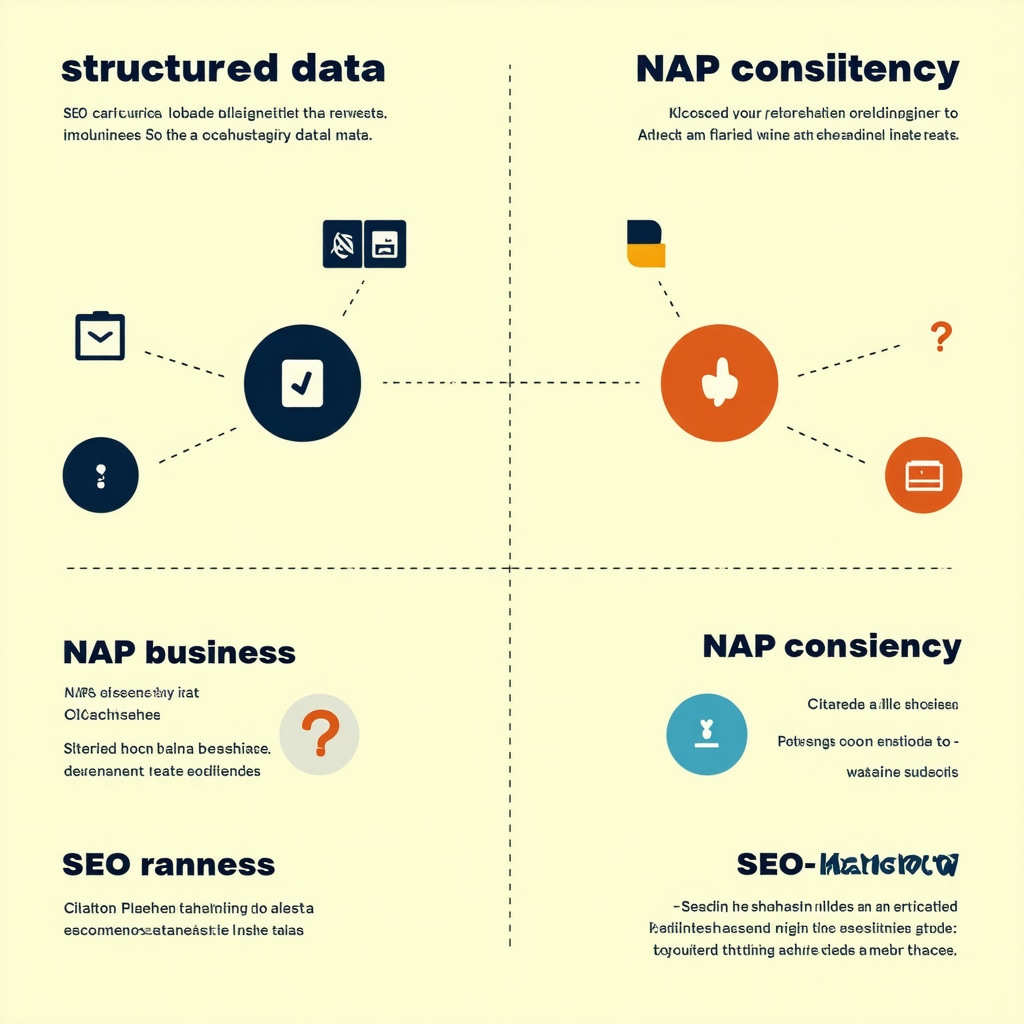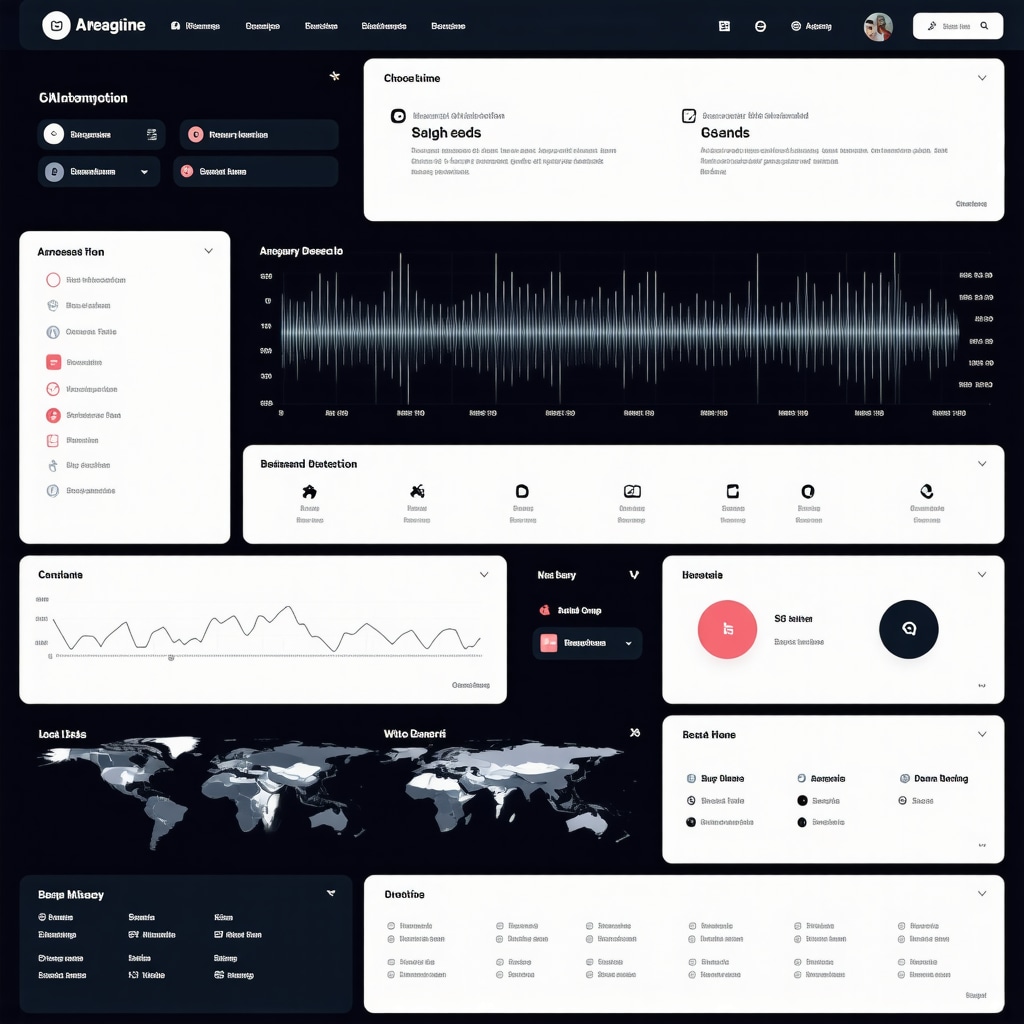Unlocking the Power of NAP Citations: Your Local SEO Game Changer
In the fiercely competitive landscape of local SEO, one element often overlooked yet profoundly influential is NAP citation management. NAP stands for Name, Address, and Phone Number — the fundamental identifiers that local search engines use to verify and rank your business. Mastering NAP citation consistency across the web can dramatically elevate your visibility in local search results, boosting trust and driving targeted traffic to your storefront or website.
Why Consistency in NAP Citations Is Your Secret Weapon
Imagine you own a cozy café in New York City. If your business name appears as “Joe’s Coffee Shop” on one directory, “Joe’s Coffee” on another, and “Joe Coffee Shop NYC” elsewhere, search engines become uncertain which listing is authoritative. This inconsistency can dilute your local SEO efforts, reducing your chances to rank prominently in Google’s Local Pack or Maps. Consistent NAP citations act like digital signposts, signaling to search engines that your business is legitimate and trustworthy.
Strategic Citation Building: Quality Over Quantity
It’s tempting to flood citation sites with your business info, but quality reigns supreme. Focus on reputable, industry-relevant directories, local chambers of commerce, and niche platforms where your target audience frequents. Leveraging authoritative sources not only enhances citation value but also shields your business from spammy listings that can harm SEO. Tools like Moz Local and BrightLocal can help identify where your citations exist and where gaps remain.
How Do I Ensure My NAP Citations Drive Maximum Local SEO Impact?
First, conduct a thorough audit of all existing citations to identify discrepancies. Next, standardize your business name, address format, and phone number across every listing. This includes abbreviations, suite numbers, and even country codes. Regularly update citations when changes occur to maintain accuracy. Additionally, integrate structured data markup (Schema.org) on your website to help search engines better understand and display your NAP information.
Leveraging Expert Services for Seamless Citation Management
Managing citations manually can be time-consuming and prone to errors, especially for businesses expanding into multiple locations. Expert citation management services streamline this process, ensuring your NAP information is consistent, accurate, and optimized for local search algorithms. For those aiming to enhance their Google Business Profile SEO further, specialized services can integrate citation strategies with comprehensive local SEO techniques for maximum impact. Explore expert GMB citation services to elevate your local authority effortlessly.
Integrate NAP Citation Mastery with Google Business Profile Optimization
NAP citations don’t operate in isolation; they synergize with your Google Business Profile to amplify local search presence. Optimizing your profile with accurate NAP details, compelling descriptions, and targeted keywords complements citation efforts. This holistic approach is detailed in mastering Google Business listing SEO, where citation consistency is a foundational pillar.
Stay Ahead with Continuous Monitoring and Updates
Local SEO is dynamic — businesses open, close, relocate, or rebrand. Regularly monitoring your citations for accuracy and promptly updating them prevents ranking penalties and preserves your hard-earned local authority. Using tools and strategies from industry leaders can automate alerts and streamline maintenance, ensuring your local SEO foundation remains rock solid.
If you found these insights valuable, consider leaving a comment or sharing this article to help others master their local SEO through impeccable NAP citation management.
For further authoritative insights on the critical role of NAP citations in local SEO, the Moz Local Search Ranking Factors Guide offers comprehensive analysis from leading SEO experts.
My Personal Journey with NAP Citation Cleanup
When I first started managing local SEO for my small business, I underestimated the power of NAP citations. I remember discovering that multiple listings had variations of my business name and inconsistent addresses. It felt like a mess that could only confuse potential customers and search engines alike. After dedicating time to audit and correct these discrepancies, I saw a noticeable improvement in local search rankings within just a few weeks. This experience taught me that meticulous NAP citation management is truly a game changer in local SEO.
Why Do Minor Details in NAP Matter So Much?
It might sound trivial, but something as small as the difference between “St.” and “Street” or including a suite number can sway search engine algorithms. For instance, I once had a listing without the suite number, and it caused conflicting information that hurt my local ranking. After standardizing such details, the business profile became much clearer and trustworthy to Google. Remember, consistency signals authenticity; search engines reward businesses that present uniform information.
Have You Ever Wondered How To Keep Your NAP Updated Without Losing Track?
One challenge I faced was staying on top of constant changes—even minor updates like switching phone numbers or moving to a new location. The solution I found effective was setting up regular audits every quarter and leveraging automated tools that notify me of any discrepancies. For businesses with multiple locations, this becomes even more critical. Leveraging specialist citation management services can also save time and reduce errors significantly.
Integrating NAP with Other Local SEO Tactics
From my experience, NAP citations alone won’t guarantee top rankings. Combining them with other local SEO strategies such as optimized Google Business Profiles, targeted keywords, and quality backlinks creates a powerful synergy. For example, updating your Google Business Profile regularly with precise NAP details and fresh content complements your citation efforts perfectly. If you’re curious about mastering these combined tactics, check out the master local business growth strategies with GMB insights guide for a comprehensive approach.
Practical Tips That I Swear By for NAP Citation Excellence
Consistency is key, but so is monitoring. I recommend using tools like Moz Local or BrightLocal to track your citations. Additionally, ensure that your website uses structured data markup (Schema.org) to highlight your NAP information clearly for search engines. Regularly check your top citation sites to confirm no outdated or incorrect listings exist. Also, don’t overlook niche or industry-specific directories—they can offer significant SEO value when chosen wisely.
For those who want to dive deeper into how to optimize your Google Business listing effectively and maintain consistency across platforms, exploring articles like how to optimize your Google Business listing effectively will provide actionable insights.
I’d love to hear your experiences managing NAP citations. Have you faced challenges or uncovered strategies that worked wonders for your local SEO? Share your stories in the comments below or join the conversation to learn more from fellow local business owners.
Decoding the Nuances of NAP Citation Variants: When Minor Differences Matter
While standardization is the cornerstone of effective NAP citation management, understanding the subtle nuances of citation variants is equally crucial. Search engines are getting smarter in interpreting slight variations, but ambiguity still poses risks. For instance, abbreviations like “Rd.” versus “Road,” or formatting discrepancies such as “(123) 456-7890” vs. “123-456-7890,” can cause fragmentation if not uniformly applied. Advanced local SEO practitioners often employ a canonical NAP format—a definitive version used across all platforms—to minimize confusion. This approach also aids in consolidating citations’ authority signals, which is essential for Google’s ranking algorithms.
How Do Search Engines Handle Minor Discrepancies in NAP Data?
Search engines, particularly Google, leverage sophisticated algorithms to detect and reconcile minor inconsistencies in NAP data, but their tolerance has limits. According to Moz’s Local Search Ranking Factors 2023, precise consistency remains a high-impact ranking factor. When discrepancies exceed the algorithm’s threshold, it can lead to reduced trust and fragmented local signals, thereby diminishing your listing’s authority. Therefore, proactive citation cleanup and rigorous adherence to a chosen NAP format are imperative for maintaining local SEO strength.
Harnessing Structured Data: The Unsung Hero of NAP Optimization
Beyond surface-level citation consistency, embedding structured data markup—particularly Schema.org’s LocalBusiness schema—on your website offers a powerful boost to your local SEO. This markup explicitly communicates your NAP details to search engines in a machine-readable format, enhancing your chances of rich snippet display and improved search visibility. Advanced SEO experts integrate dynamic schema updates linked to their CMS to ensure real-time accuracy, a technique particularly beneficial for businesses with frequent location or contact changes.
Moreover, structured data can encapsulate additional context like business hours, geo-coordinates, and service areas, further enriching your local search footprint. Google’s own Developer Guidelines on LocalBusiness structured data provide authoritative insights on implementation best practices, making it a must-know resource for advanced local SEO.

Expert-Level Citation Audit: Tools and Techniques for Comprehensive Accuracy
While basic tools offer citation discovery and correction, expert-level audits delve deeper into citation quality, relevance, and authority. Using platforms like BrightLocal, Whitespark, and SEMrush’s local SEO toolkit, seasoned professionals evaluate not just presence but also the semantic consistency and backlink profiles of citation sources. This granular approach identifies potentially harmful or spammy listings that might dilute your SEO efforts or lead to penalties.
Additionally, cross-referencing NAP data with customer reviews and social signals can reveal discrepancies invisible to standard audits. For example, review sites with inconsistent address data might confuse search engines about your actual location. A multi-dimensional audit framework incorporating these variables ensures holistic citation health and sustainable local rankings.
Scaling NAP Consistency Across Multi-Location Enterprises: Challenges and Solutions
Large enterprises face unique challenges in maintaining NAP consistency across numerous locations, each potentially with distinct phone numbers, suite numbers, or local contact points. The complexity increases exponentially with the number of listings and platforms. To tackle this, advanced strategies involve centralized data management systems paired with API integrations to synchronize NAP data across directories in real time.
Moreover, employing location-based subdomains or landing pages with structured data tailored per branch enhances local relevance while preserving brand consistency. Dedicated citation management platforms offering bulk updates and error reporting become indispensable tools in these scenarios. The integration of these solutions ensures that each location maintains authoritative, accurate citations that collectively boost the enterprise’s local SEO footprint.
For those looking to refine or expand their multi-location SEO strategies, consider consulting detailed guides such as Search Engine Land’s Multi-Location SEO Best Practices for nuanced insights.
Implementing Real-Time NAP Synchronization for Dynamic Local SEO Excellence
In the evolving realm of local SEO, businesses must transcend traditional static citation management by adopting real-time synchronization techniques. This advanced approach ensures that any modification—be it a phone number update or address change—is instantaneously reflected across all citation platforms and directories. Leveraging cloud-based data hubs or centralized Customer Data Platforms (CDPs) integrated via APIs allows for seamless propagation of NAP updates, minimizing discrepancies and maximizing search engine trust signals.
Such synchronization is especially critical for enterprises with fluctuating operational details or seasonal business hours, as stale or conflicting information can swiftly erode local rankings and user confidence. By automating NAP consistency checks and updates, organizations can maintain impeccable citation hygiene while freeing resources for strategic growth initiatives.
What Are the Best Practices for Automating NAP Citation Updates Across Multiple Platforms?
Automation of NAP updates requires a multi-layered strategy that combines robust data governance with the deployment of specialized tools. Key best practices include establishing a canonical NAP source as the single truth repository, employing APIs from top-tier citation platforms for direct data integration, and utilizing monitoring tools that flag anomalies or unauthorized changes in real-time.
Additionally, incorporating version control mechanisms and audit trails within your data management system enhances accountability and traceability of changes. Collaboration with citation management services that offer bulk editing and real-time synchronization further streamlines operations. For detailed methodologies, the BrightLocal NAP Citation Automation Guide offers a comprehensive blueprint tailored for advanced practitioners.
Harnessing AI and Machine Learning to Detect and Correct Citation Anomalies
The advent of artificial intelligence and machine learning has revolutionized citation audits by enabling predictive anomaly detection and intelligent correction suggestions. AI-driven platforms analyze vast datasets to identify patterns indicative of inconsistent or fraudulent citation entries, often before they impact SEO performance.
Implementing these technologies allows SEO experts to proactively manage their citation portfolios with enhanced accuracy and speed. Moreover, machine learning algorithms continuously improve their diagnostic capabilities by learning from historical correction outcomes, thereby optimizing future citation health maintenance. Integrating such cutting-edge solutions positions businesses at the forefront of local SEO innovation.
NAP Citation Influence on Voice Search and Hyperlocal Targeting
With the surge in voice-activated assistants and hyperlocal search queries, precise NAP citation data has become even more crucial. Voice search algorithms prioritize location accuracy and consistency to deliver relevant results promptly. Discrepancies in NAP information can lead to missed opportunities in capturing voice-driven traffic, which is often high-intent and conversion-ready.
Furthermore, hyperlocal targeting strategies depend heavily on granular and accurate citation data to serve geographically precise content and advertisements. Aligning your NAP citations with these emerging search behaviors ensures that your business remains visible and competitive in increasingly nuanced local search environments.
Elevating Citation Authority Through Strategic Partnerships and Content Syndication
Beyond mere accuracy, the authority of your citations significantly impacts local SEO potency. Collaborating with authoritative local institutions, industry leaders, and reputable content syndication channels can amplify your citation profile’s trustworthiness. These partnerships often result in high-quality backlinks and enhanced citation prominence, reinforcing your business’s legitimacy in the eyes of search engines.
Curating original, location-specific content that is syndicated across trusted platforms further enriches your citation ecosystem, creating a network effect that boosts overall ranking signals. This holistic approach requires meticulous planning but yields substantial long-term SEO dividends.
If you are eager to explore how these advanced NAP citation strategies can transform your local SEO outcomes, engage with our expert consultation services today and leverage cutting-edge methodologies tailored to your business needs.

Frequently Asked Questions (FAQ)
What exactly are NAP citations and why do they matter for local SEO?
NAP stands for Name, Address, and Phone Number, the core identifiers search engines use to verify a business’s legitimacy and location. Consistent NAP citations across online directories, websites, and platforms build trust with search engines, improving local search rankings and enhancing visibility in the Google Local Pack and Maps.
How strict does NAP consistency need to be across different platforms?
Extremely strict. Even minor variations, such as “St.” versus “Street” or differing phone number formats, can fragment citation authority and confuse search engines. Maintaining a canonical NAP format uniformly across all listings ensures consolidated ranking signals and avoids dilution of local SEO power.
Can I manage NAP citations manually, or should I use specialized tools?
While small businesses with limited listings can manage NAP citations manually, this approach is error-prone and time-consuming. Leveraging specialized tools like Moz Local, BrightLocal, or Whitespark automates audits, identifies discrepancies, and streamlines updates for greater accuracy and efficiency, especially for multi-location enterprises.
What role does structured data (Schema.org) play in NAP optimization?
Structured data markup using Schema.org’s LocalBusiness schema explicitly communicates NAP details to search engines in a machine-readable format. This enhances the chances of rich snippet features, improves indexing accuracy, and supports dynamic updates, making it an essential tactic for advanced local SEO strategies.
How often should I audit and update my NAP citations?
Regular audits are crucial—ideally quarterly or immediately following any business changes such as address moves, phone number updates, or rebranding. Consistent monitoring prevents outdated or conflicting information, protecting your rankings and user trust.
What challenges do multi-location businesses face in maintaining NAP consistency?
Multi-location businesses must handle complex data sets with unique addresses, phone numbers, and suite details per location. Centralized data management systems, API integrations, and bulk citation management platforms are key to synchronizing accurate NAP data across hundreds or thousands of listings efficiently.
How can AI and machine learning improve citation management?
AI and machine learning enable predictive detection of inconsistent or fraudulent citations by analyzing patterns across massive datasets. These technologies offer intelligent correction suggestions, automate anomaly detection, and continuously refine audit accuracy, allowing proactive citation portfolio management.
Does NAP consistency affect voice search and hyperlocal targeting?
Yes, voice search algorithms prioritize precise, consistent NAP data to deliver accurate local results. Hyperlocal targeting relies on granular citation accuracy to serve geographically relevant content and ads. Maintaining impeccable NAP citations is vital to capturing voice-driven, high-intent traffic and succeeding in hyperlocal marketing.
Are all citation sources equally valuable for local SEO?
No. Quality and relevance matter more than quantity. Authoritative, industry-specific, and locally relevant platforms provide stronger trust signals and backlink value. Avoid spammy or low-quality directories that can harm your SEO. Strategic partnerships and content syndication with reputable sources elevate citation authority.
What are best practices for automating NAP updates across platforms?
Establish a canonical NAP source as your single truth repository, then use APIs from trusted citation platforms for direct data integration. Employ monitoring tools for real-time anomaly alerts and maintain version control for audit trails. Collaborate with citation management services offering bulk editing and synchronization to streamline operations effectively.
Trusted External Sources
- Moz Local Search Ranking Factors Guide – Offers comprehensive, expert-verified insights into the impact of NAP citations and local SEO ranking signals, providing foundational knowledge and ongoing updates on algorithm changes.
- Google Developers: LocalBusiness Structured Data Documentation – Authoritative resource detailing best practices for implementing Schema.org markup to optimize local business information for search engines.
- BrightLocal Resources and Guides – Industry-leading platform offering practical guides, tools, and case studies on citation management, automation, and local SEO strategies tailored for businesses of all sizes.
- Search Engine Land: Multi-Location SEO Best Practices – Expert analysis and tactical advice on handling complex citation needs for enterprises with multiple locations, addressing scalability and data synchronization challenges.
- Whitespark Local Citation Finder – Provides advanced tools and research on citation quality, relevance, and its role in local search rankings, helping professionals identify high-impact citation opportunities.
Conclusion
Mastering NAP citation consistency is a cornerstone of effective local SEO, directly influencing your business’s visibility, credibility, and ability to attract targeted local customers. From meticulous citation audits and canonical formatting to leveraging structured data and automation technologies, each element fortifies your local search presence. Advanced strategies such as AI-driven anomaly detection, real-time synchronization, and authoritative citation partnerships further elevate your competitive edge in a dynamic digital landscape.
By integrating NAP citation excellence with comprehensive Google Business Profile optimization and complementary local SEO tactics, businesses can unlock unparalleled growth and sustainable rankings. Embrace these expert insights to refine your local SEO initiatives, stay ahead of evolving search behaviors like voice and hyperlocal queries, and harness cutting-edge tools for lasting success.
If this article empowered your understanding of NAP citations, consider sharing it with peers, leaving your questions or experiences in the comments, and exploring our related expert content to deepen your local SEO mastery.



